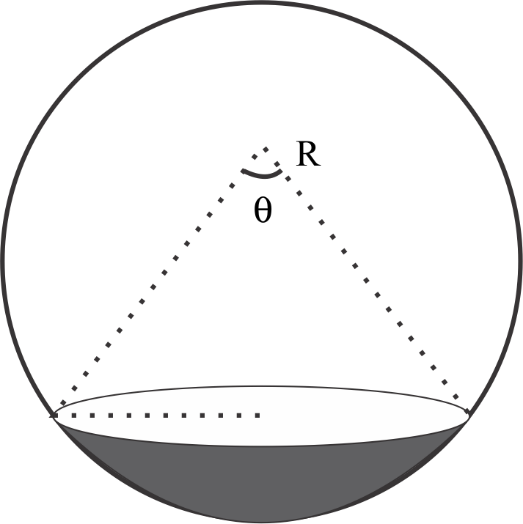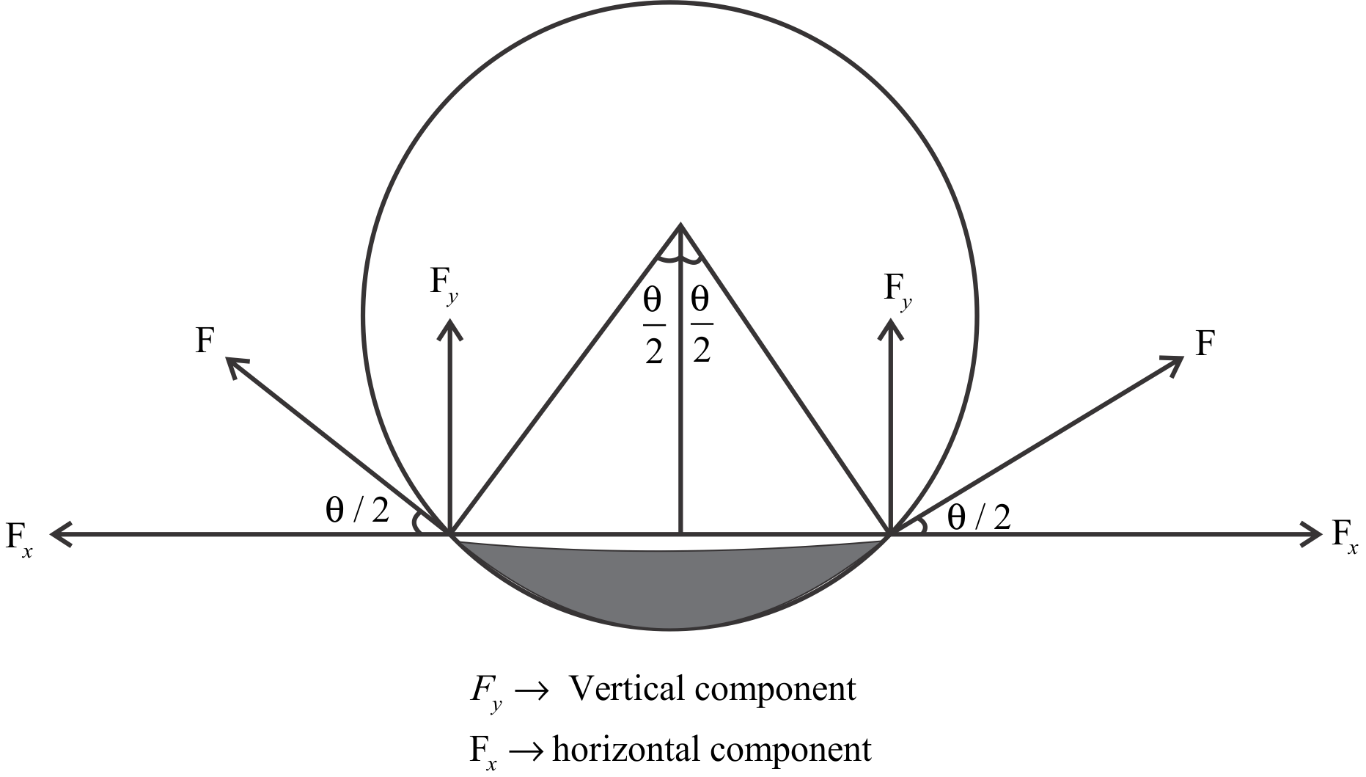
Consider a spherical drop of radius R. Surface tension of the liquid is S. Force of the surface tension on the shaded sub hemisphere due to remaining drop is $\dfrac{{S\pi R}}{2}$. The value of angle $\theta $ (angle subtended by the sub hemisphere at centre of drop) is

(A) $60^\circ $
(B) $120^\circ $
(C) $30^\circ $
(D) $90^\circ $
Answer
217.8k+ views
Hint We are provided with the force of the surface tension on the shaded sub hemisphere due to the remaining drop being $\dfrac{{S\pi R}}{2}$. We can understand that statement from the diagram in the question. We have to find the angle subtended by the sub hemisphere at centre of drop. Use the surface tension formula to find the angle. Since the given surface is a sphere its radius makes an angle with the centre point. Use the given diagram for better understanding.
Complete step by step answer
Surface tension: The tendency of surfaces to shrink into the possible minimum surface area. The surface tension is the force per unit length of the surface. Surface area of an object is given by
$ \Rightarrow \gamma = \dfrac{F}{l}$
$\gamma $ is the surface tension
F is the force
L is the unit length
Given,
The radius of a spherical drop is R
Surface tension of the liquid is S
Force of the surface tension on the shaded sub hemisphere due to remaining drop is $F = \dfrac{{S\pi R}}{2}$.
Angle subtended by the sub hemisphere at centre of drop $\theta = ?$

We know that
$ \Rightarrow \gamma = \dfrac{F}{l}$
$ \Rightarrow F = \gamma \times l$
Substituting the known values,
$ \Rightarrow F = \gamma \times l$
$ \Rightarrow F = S \times 2\pi R$
From the diagram
$ \Rightarrow F = S \times 2\pi R\sin \dfrac{\theta }{2}{\text{ }} \to {\text{1}}$
From the diagram,
All the horizontal components of the force get cancelled.
The net force by vertical component of force
$ \Rightarrow F = F\sin \dfrac{\theta }{2}$
Given $F = \dfrac{{S\pi R}}{2}$
$ \Rightarrow \dfrac{{S\pi R}}{2} = F\sin \dfrac{\theta }{2}$
From equation 1
$ \Rightarrow \dfrac{{S\pi R}}{2} = S \times 2\pi R\sin \dfrac{\theta }{2} \times \sin \dfrac{\theta }{2}$
$ \Rightarrow \dfrac{{S\pi R}}{2} = S \times 2\pi R{\sin ^2}\dfrac{\theta }{2}$
\[ \Rightarrow \dfrac{1}{2} = \times 2{\sin ^2}\dfrac{\theta }{2}\]
\[ \Rightarrow {\sin ^2}\dfrac{\theta }{2} = \dfrac{1}{4}\]
Taking square root
\[ \Rightarrow \sin \dfrac{\theta }{2} = \dfrac{1}{2}\]
\[ \Rightarrow \dfrac{\theta }{2} = {\sin ^{ - 1}}\dfrac{1}{2}\]
\[ \Rightarrow \dfrac{\theta }{2} = 30^\circ \]
\[ \Rightarrow \theta = 60^\circ \]
Angle subtended by the sub hemisphere at centre of drop, \[\theta = 60^\circ \]
Hence the correct answer is option (A) \[60^\circ \]
Note We can notice that we have used $2\pi R$ in place of L while solving. Surface tension is the force per unit length. Here we are provided with a sphere. To find the surface tension on the sphere we have to use the circumference of the sphere. Circumference of the sphere is $2\pi R$.
Complete step by step answer
Surface tension: The tendency of surfaces to shrink into the possible minimum surface area. The surface tension is the force per unit length of the surface. Surface area of an object is given by
$ \Rightarrow \gamma = \dfrac{F}{l}$
$\gamma $ is the surface tension
F is the force
L is the unit length
Given,
The radius of a spherical drop is R
Surface tension of the liquid is S
Force of the surface tension on the shaded sub hemisphere due to remaining drop is $F = \dfrac{{S\pi R}}{2}$.
Angle subtended by the sub hemisphere at centre of drop $\theta = ?$

We know that
$ \Rightarrow \gamma = \dfrac{F}{l}$
$ \Rightarrow F = \gamma \times l$
Substituting the known values,
$ \Rightarrow F = \gamma \times l$
$ \Rightarrow F = S \times 2\pi R$
From the diagram
$ \Rightarrow F = S \times 2\pi R\sin \dfrac{\theta }{2}{\text{ }} \to {\text{1}}$
From the diagram,
All the horizontal components of the force get cancelled.
The net force by vertical component of force
$ \Rightarrow F = F\sin \dfrac{\theta }{2}$
Given $F = \dfrac{{S\pi R}}{2}$
$ \Rightarrow \dfrac{{S\pi R}}{2} = F\sin \dfrac{\theta }{2}$
From equation 1
$ \Rightarrow \dfrac{{S\pi R}}{2} = S \times 2\pi R\sin \dfrac{\theta }{2} \times \sin \dfrac{\theta }{2}$
$ \Rightarrow \dfrac{{S\pi R}}{2} = S \times 2\pi R{\sin ^2}\dfrac{\theta }{2}$
\[ \Rightarrow \dfrac{1}{2} = \times 2{\sin ^2}\dfrac{\theta }{2}\]
\[ \Rightarrow {\sin ^2}\dfrac{\theta }{2} = \dfrac{1}{4}\]
Taking square root
\[ \Rightarrow \sin \dfrac{\theta }{2} = \dfrac{1}{2}\]
\[ \Rightarrow \dfrac{\theta }{2} = {\sin ^{ - 1}}\dfrac{1}{2}\]
\[ \Rightarrow \dfrac{\theta }{2} = 30^\circ \]
\[ \Rightarrow \theta = 60^\circ \]
Angle subtended by the sub hemisphere at centre of drop, \[\theta = 60^\circ \]
Hence the correct answer is option (A) \[60^\circ \]
Note We can notice that we have used $2\pi R$ in place of L while solving. Surface tension is the force per unit length. Here we are provided with a sphere. To find the surface tension on the sphere we have to use the circumference of the sphere. Circumference of the sphere is $2\pi R$.
Recently Updated Pages
Elastic Collision in Two Dimensions Explained Simply

Elastic Collisions in One Dimension Explained

Electric Field Due to a Uniformly Charged Ring Explained

Electric Field of Infinite Line Charge and Cylinders Explained

Electric Flux and Area Vector Explained Simply

Electric Field of a Charged Spherical Shell Explained

Trending doubts
JEE Main 2026: Application Form Open, Exam Dates, Syllabus, Eligibility & Question Papers

Derivation of Equation of Trajectory Explained for Students

Hybridisation in Chemistry – Concept, Types & Applications

Understanding the Angle of Deviation in a Prism

Understanding Collisions: Types and Examples for Students

How to Convert a Galvanometer into an Ammeter or Voltmeter

Other Pages
JEE Advanced Marks vs Ranks 2025: Understanding Category-wise Qualifying Marks and Previous Year Cut-offs

Units And Measurements Class 11 Physics Chapter 1 CBSE Notes - 2025-26

NCERT Solutions For Class 11 Physics Chapter 8 Mechanical Properties Of Solids

Motion in a Straight Line Class 11 Physics Chapter 2 CBSE Notes - 2025-26

NCERT Solutions for Class 11 Physics Chapter 7 Gravitation 2025-26

Understanding Atomic Structure for Beginners




